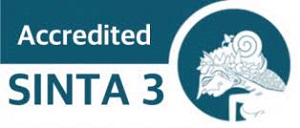ADDITIONAL MENU
Development of a CNN-Based Mental Health Consultation Application Integrating Facial Expressions and DASS-42 Questionnaire
Abstract
Early detection of psychological disorders such as Depression, stress, and anxiety is still limited due to a lack of awareness and inadequate access to mental health consultation services. This study aims to develop a mental health consultation application that utilizes facial expressions and the Depression, Anxiety, and Stress Scale (DASS-42) questionnaire, employing a Convolutional Neural Network (CNN) algorithm. The CNN algorithm is used to detect and classify facial expressions into emotional categories, such as anger, sadness, disgust, and fear, as early indicators of mental conditions. In addition, the DASS-42 questionnaire provides a structured psychological assessment to determine the severity of Depression, anxiety, and stress. This combination offers a more comprehensive and accurate evaluation, thus bridging the gap in early detection methods for mental health. Based on the development and testing results, a mental health consultation app utilizing facial expressions and the DASS-42 questionnaire was successfully created by using the CNN algorithm as a facial expression detector. The system can identify facial expressions such as sadness, anger, disgust, and fear with an accuracy of 81%, showing excellent performance in detecting early signs of mental disorders.
Keywords
Convolutional Neural Network; DASS-42; Facial Expression; Mental Health
Full Text:
PDFReferences
W. H. Organization, “World Mental Health Report: Transforming Mental Health for All,” 2023. [Online]. Available: https://www.who.int/publications/i/item/9789240049338
UNICEF, “The State of the World’s Children 2021: On My Mind – Promoting, protecting and caring for children’s mental health. New York: United Nations Children’s Fund,” 2021. [Online]. Available: https://www.unicef.org/reports/state-worlds-children-2021
A. Mertens, A., Viechtbauer, W., & Raes, “The effectiveness of the DASS-21 for screening mental disorders in the general population,” Psychiatry Res., vol. 279, pp. 180–185, 2019, doi: https://doi.org/10.1016/j.psychres.2019.07.059.
A. Alam, M. M., Iqbal, T., & Yousaf, “Deep CNN-based facial expression recognition for psychological disorder detection using FER-2013 dataset,” Neural Comput. Appl., vol. 35, pp. 12123–12135, 2023, doi: https://doi.org/10.1007/s00521-023-08536-1.
Y. Han, S. Y., & Kim, “Multimodal emotion recognition using facial expression and self-reported emotion questionnaire for depression prediction,” Sensors, vol. 22, no. 7, pp. 15–28, 2022, doi: https://doi.org/10.4018/IJSE.2020010102.
M. Gunes, H., & Pantic, “Automatic, dimensional and continuous emotion recognition,” Int. J. Synth. Emot., vol. 10, no. 1, pp. 15–28, 2020, doi: https://doi.org/10.4018/IJSE.2020010102.
M. H. Mollahosseini, A., Hasani, B., & Mahoor, “AffectNet: A database for facial expression, valence, and arousal computing in the wild,” IEEE Trans. Affect. Comput., vol. 10, no. 1, pp. 18–31, 2019, doi: https://doi.org/10.1109/TAFFC.2017.2740923.
S. Deng, J., Guo, J., & Zafeiriou, “ArcFace: Additive Angular Margin Loss for Deep Face Recognition,” IEEE Trans. Pattern Anal. Mach. Intell., vol. 44, no. 10, pp. 5740–5753, 2020, doi: https://doi.org/10.1109/TPAMI.2020.2988356.
A. Lopes, F. M., de Aguiar, E., & de Souza, “Early detection of depression based on facial expressions using convolutional neural networks,” Expert Syst. Appl., vol. 183, p. 115390, 2021, doi: https://doi.org/10.1016/j.eswa.2021.115390.
S. Kusuma, B. D., & Wahyuni, “Integration of CNN-based facial emotion recognition and DASS-42 for mental health screening system,” J. Intell. Fuzzy Syst., vol. 43, no. 6, pp. 7367–7376, 2022, doi: https://doi.org/10.3233/JIFS-212148.
A. A. Rimi, “9 Facial Expressions for YOLO,” Kaggle. [Online]. Available: https://www.kaggle.com/datasets/aklimaakterrimi/9-facial-expressions-for-yolo
Y. Zhao, Q., Xu, X., Wang, Y., & Liu, “An enhanced facial emotion recognition method based on attention CNN and residual learning,” Sensors, vol. 23, no. 2, p. 945, 2023, doi: https://doi.org/10.3390/s23020945.
R. Tarnowski, P., Kołodziej, M., Majkowski, A., & Rak, “Emotion recognition using facial expressions,” Procedia Comput. Sci., vol. 176, pp. 2926–2935, 2020, doi: https://doi.org/10.1016/j.procs.2020.09.178.
A. Dey, A., Roy, S., & Banerjee, “Real-time emotion detection using CNN and its applications in mental health support,” J. Ambient Intell. Humaniz. Comput., vol. 14, pp. 383–396, 2023, doi: https://doi.org/10.1007/s12652-022-03684-1.
M. Jain, S., Lall, B., & Sharma, “Ethical implications of AI-based emotion detection: A privacy-aware review,” AI Ethics, vol. 2, no. 2, pp. 195--207, 2021, doi: https://doi.org/10.1007/s43681-021-00047-4.
D. Oguine, O. C., Oguine, K. J., Bisallah, H. I., & Ofuani, “Hybrid FER model for real-time emotion classification on FER2013 dataset.,” arXiv Is Hiring a DevOps Eng., 2022.
R. A. Aniobi, D. E., Benisemeni, Z. E., & Zira, “Augmenting the FER2013 dataset for enhanced facial expression recognition: A comparative study of data augmentation techniques,” Int. J. Innov. Sci. Eng., vol. 35, no. 4, 2023.
K. Ahmed, T. U., Hossain, S., Shahadat Hossain, M., & Andersson, “Facial expression recognition model based on CNN and data augmentation,” IJRCom, 2023.
M. Çetin, M., Şahin, E., & Turgut, “Development and psychometric validation of screening tools integrating DASS‑42 subscales,” J. Psychol. Res., 2024.
P. F. Lovibond, S. H. & Lovibond, Manual for the Depression Anxiety Stress Scales, 2nd ed. Psychology Foundation of Australia, 2021.
K. Ali, R. A.; Tan, J.; Lee, “ssessment of psychological distress using DASS-42 during the post-pandemic era: A validation study among university students,” BMC Psychol., vol. 11, no. 1, p. 25, 2023, doi: https://doi.org/10.1186/s40359-023-01051-4.
DOI: http://dx.doi.org/10.24014/ijaidm.v8i2.37525
Refbacks
- There are currently no refbacks.
Office and Secretariat:
Big Data Research Centre
Puzzle Research Data Technology (Predatech)
Laboratory Building 1st Floor of Faculty of Science and Technology
UIN Sultan Syarif Kasim Riau
Jl. HR. Soebrantas KM. 18.5 No. 155 Pekanbaru Riau – 28293
Website: http://predatech.uin-suska.ac.id/ijaidm
Email: ijaidm@uin-suska.ac.id
e-Journal: http://ejournal.uin-suska.ac.id/index.php/ijaidm
Phone: 085275359942
Journal Indexing:
Google Scholar | ROAD | PKP Index | BASE | ESJI | General Impact Factor | Garuda | Moraref | One Search | Cite Factor | Crossref | WorldCat | Neliti | SINTA | Dimensions | ICI Index Copernicus
IJAIDM Stats










